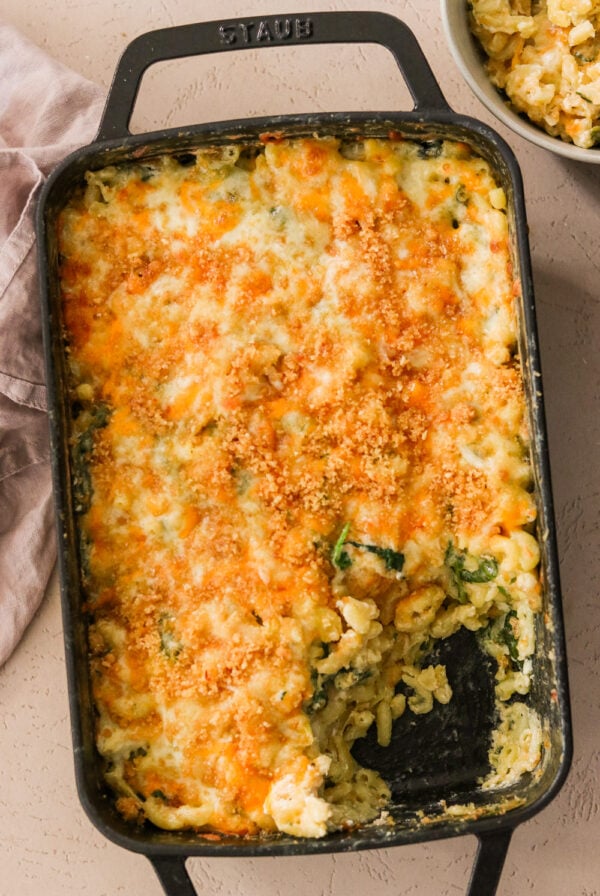This post may contain affiliate links. Please see our disclosure policy.
An easy, 25-minute recipe turning spicy, saucy gochujang noodles into a protein-packed, stir-fried recipe that won’t disappoint! This Korean spicy noodles dish is made with rice noodles, zucchini spirals, and shrimp tossed in an addicting sweet and spicy gochujang sauce. Simple, delicious, and easily stored for a flavorful “leftovers” lunch the next day!

What Makes This Recipe Great
Flavorful, spicy, and saucy gochujang noodles that come together in under 30 minutes. A simple stir-fried dish with shrimp, zucchini, and rice noodles coated in an addicting, delicious sauce.
While not a traditional Korean dish, this noodle recipe incorporates Korean flavors like spicy gochujang and rice noodles into a super easy, tasty meal. This is an easy noodle dish to throw together in a pinch, and much healthier than instant noodles or other prepared foods. It’s also completely gluten-free!
Easily customized to your spice level, you will love this subtly sweet, spicy, and saucy dish!
If you love gochujang, try my Kimchi Braised Pork Ribs or these Korean Sloppy Joes!
Watch a Short Video of This Recipe
Ingredient Notes

Spicy Noodles
- Zucchini: You’ll want to get one large zucchini and spiralize it.
- Shrimp: Use fresh or frozen shrimp.
- Rice Noodles: Rice noodles are smooth and chewy, which helps to absorb the sauce well. Also complements well with the slightly crunchy zucchini noodles.
- Avocado Oil: Or another neutral cooking oil of your choice.
- Salt
- Chopped Green Onion & Sesame Seeds: Optional, for garnish.
Gochujang Sauce
- Gochujang: Also known as Korean red pepper paste. This is a gluten-free dish, but read the label to make sure there’s no wheat in your gochujang. This brand is gluten-free.
- Tamari: If you aren’t gluten-free, you can replace the tamari sauce with soy sauce. If you’re soy-free, use coconut aminos.
- Water
- Almond Butter: Or your favorite nut or seed butter.
- Rice Vinegar
- Coconut Sugar: You can also use brown sugar if preferred.
- Toasted Sesame Oil
- Garlic Cloves: Mince fresh garlic cloves or use a jar of minced garlic.
Step-by-Step Instructions

- Cut the spiralized zucchini if they are too long. Place in a large colander and toss with sea salt. Let this sit while you prepare the rest of the recipe.
- Add all ingredients for the gochujang sauce in a bowl and whisk together to combine. Set aside.
- Pat dry the shrimp with a paper towel and heat avocado oil in a large skillet over medium-high heat. Add shrimp in a single layer, and pan fry for 1-2 minutes on each side until opaque. Remove the shrimp from the pan and set aside.
- Cook the rice noodles according to the package instructions. Drain and place in the pan that the shrimp was cooked in. Turn the heat on to medium-high, pour gochujang sauce over the noodles, and stir, cooking for 2 minutes.
- Squeeze the zucchini noodles to remove as much liquid as possible. Add the squeezed zucchini and shrimp to the skillet with the cooked noodles, and stir to coat in sauce.
- Turn off the heat, and serve sprinkled with sesame seeds and green onions.

Expert Tips
- Spice level: This is a spicy dish, so if you want to make it less spicy – reduce the gochujang to 2-3 tbsp.
- Shrimp: You can use fresh or frozen shrimp. Just be aware that with frozen shrimp you will need to thaw them before cooking, or follow the package directions for the cooking time for cooking shrimp directly from frozen.
- Zucchini Noodles: If you’d prefer, you can omit the zucchini noodles and just use rice noodles.
- Veggies: Feel free to add additional sauteed veggies to these gochujang noodles if you would like.
Storage Tips
- Store leftovers in an airtight container in the refrigerator for up to three days.
- Reheat over the stovetop or in the microwave. Stir the noodles occasionally to break them up. Add more sauce and garnish, if desired.

Recipe FAQs
You can find these ingredients at local Asian Markets, some big box grocery stores, and online! In fact, Thrive Market sells rice noodles by Lotus Foods that I used in this recipe and love. For gluten-free gochujang, try this brand I use, found on Amazon.
In one serving of this dish, there are a little under 500 calories and 23 grams of protein. It is healthier than storebought or takeout versions, but as always, it’s best eaten in moderation.

Gochujang Noodles (Korean Spicy Noodles)
Video
Ingredients
- 2 large zucchini, spiralized
- 1 tsp sea salt
- 1 lb large shrimp
- 1 tbsp avocado oil, or your favorite cooking oil
- 10 oz rice noodles
- Chopped green onions and sesame seeds, for garnish
Gochujang Sauce
- 1/4 cup gochujang, this one is gluten free
- 3 tbsp tamari sauce, coconut aminos, for soy free
- 2 tbsp water
- 2 tbsp almond butter, or your favorite nut or seed butter
- 1 tbsp rice vinegar
- 1 tbsp coconut sugar, or brown sugar
- 2 tsp sesame oil
- 4 garlic cloves , minced
Instructions
- Cut the spiralized zucchini if they are too long. Place in a large colander and toss with sea salt. Let this sit while you prepare the rest of the recipe.
- Add all ingredients for the gochujang sauce in a bowl and whisk together to combine. Set aside.
- Pat dry the shrimp with a paper towel and heat avocado oil in a large skillet over medium high heat. Add shrimp in a single layer, and pan fry for 1-2 minutes on each side until opaque. Remove the shrimp from the pan and set aside.
- Cook rice noodles according to package instructions. Drain and place in the pan that the shrimp was cooked in. Turn the heat on to medium high, pour gochujang sauce over the noodles, and stir cooking for 2 minutes.
- Squeeze zucchini noodles to remove as much liquid as possible. Add the squeezed zucchini and shrimp to the skillet with the rice noodles, and stir to coat in sauce.
- Turn off heat, and serve sprinkled with sesame seeds and green onions.
Notes
Expert Tips
- Spice level: This is a spicy dish, so if you want to make it less spicy – reduce the gochujang to 2-3 tbsp.
- Shrimp: You can use fresh or frozen shrimp. Just be aware that with frozen shrimp you will need to thaw them before cooking, or follow the package directions for the cooking time for cooking shrimp directly from frozen.
- Zucchini Noodles: If you’d prefer, you can omit the zucchini noodles and just use rice noodles.
- Veggies: Feel free to add additional sauteed veggies to these gochujang noodles if you would like.
Storage Tips
- Store leftovers in an airtight container in the refrigerator for up to three days.
- Reheat over the stovetop or in the microwave. Stir the noodles occasionally to break them up. Add more sauce and garnish, if desired.
Nutrition
Nutrition information is automatically calculated, so should only be used as an approximation.
What Great Grandma Ate / Jean Choi is a participant in the Amazon Services LLC Associates Program, an affiliate advertising program designed to provide a means for sites to earn advertising fees by advertising and linking to Amazon.com.
Regarding other affiliate links and affiliate relationships: In order for me to support my blogging activities, I may receive monetary compensation or other types of remuneration for my endorsement, recommendation, testimonial and/or link to any products or services from this blog. Thank you for your support and understanding.






Could this be made with any other noodle-I am sensitive to rice? Thanks so much. Looks so yummy.
Sure! You can use any other noodle you want.
This is soooo good! The only substitution I made was to use cashew butter instead of almond butter and the sauce was super yummy. I am not a fan of peeling shrimp, but this recipe was worth it.
I’m so glad you enjoyed it! Yes – any nut butter should work just fine. I usually just buy peeled shrimp because I’m lazy about it too haha. Thanks so much for leaving a review!
We really loved this! Easy, fast and delicious!
Thank you so much!